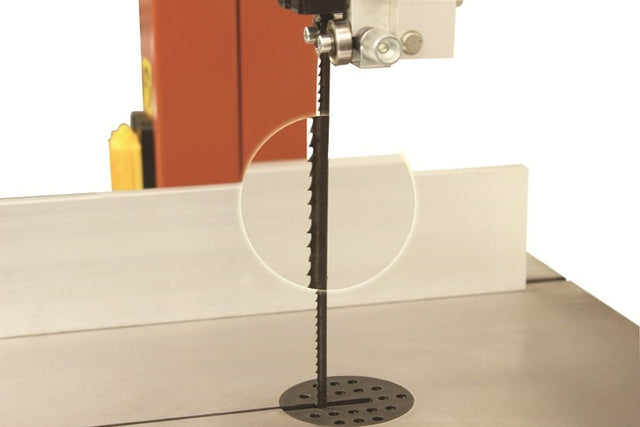Sherwood Bandsaw Blades 4115mm Flexback
Sale ends in:
Sherwood Bandsaw Blades 4115mm Flexback - 6mm x 4tpi is backordered and will ship as soon as it is back in stock.
Request Further Information
Sherwood Bandsaw Blades 4115mm Flexback
![]() Eligible for FREE Shipping*
Eligible for FREE Shipping*
Timbecon stock a broad range of quality Sherwood Bandsaw Blades for sawing wood. Whether you're a professional or enthusiast maker, we have the Bandsaw Blade for you.
These blades fit the Sherwood SBSHD-450-L. Please select your preferred size.
Sherwood Flexback Bandsaw Blades
Sherwood flexback bandsaw blades are perfect for small wheel diameter Bandsaws. The combination of a fine gauge (kerf) and an elastic spine reduces the likelihood of the blade buckling or snapping when performing radius cuts. The impulse hardened carbon-steel teeth are specifically designed with a hook and gullet that is optimal for cutting timber.
Thin Kerf, Hardened Teeth
Just like thin kerf circular saw blades, it takes less power to drive and creates less waste, making deeper cuts are quicker & easier than before. Each tooth on the blade is hardened to Rockwell Rc80, making it resistant to heat build-up, increasing blade life and strength. A unique heat line along the back of the blade ensures that the blade will not buckle giving you a straighter cut.
Chip Breaker Design
Each tooth of the blade shaped with a chip-breaker – this allows the blade to remove waste more efficiently, reducing heat build-up, improving and extending cutting performance.
Increased Hook Angle and Tooth Set
The increased hook allows the teeth cut more aggressively, whilst still leaving a smooth finish, making the cuts fast and easy to control. Standard set teeth do not affect hardwood cutting yet can affect cutting resinous timbers such as Pine. With an increased set, these blades can handle a wider range of materials.
Butt Welded
The strongest method of welding for blades available. We guarantee these blades will never break on the weld – ever.
Choosing a Bandsaw Blade
There is no one bandsaw blade for every situation, rather the blade you choose is determined by the type of work you do. Choosing the ideal blade for your project is based on a combination of several factors as discussed below. Most woodworkers will keep several bandsaw blades to suit a range of tasks, swapping them out when required.
Interpreting a bandsaw blade label
All bandsaw blades listed on the Timbecon website have a typical three-part descriptive format. Here is an example:
Title: Bandsaw Blade 1830 x 6mm 4 TPI
SKU: BS-18300604
Part 1 – Length of the blade
The first part of the SKU references the length of the blade measured in millimetres. In this case it is: 1830 (BS-18300604). This number determines whether the blade will fit on your bandsaw. Your bandsaw may not match exactly the lengths of blades available, however, as bandsaws upper wheels are adjustable a blade length of ±15mm will usually fit your machine.
Part 2 – Width of the blade
The second part of the SKU references the width of the blade, from the tip of the blade tooth to the back of the blade. In this case it is: 6mm (BS-18300604).
The width of the blade in part determines the application of the blade. The general rules of thumb:
-
Blades 9mm or less, are great for sawing detailed and curved work.
-
Blades 10 to 20mm are general purpose and suited for a range of tasks.
-
Blades over 20mm in width are great for straight sawing such as deep or long edge ripping.
It is important to know what the maximum width of blade your bandsaw can accept. Generally, the maximum width of blade usable is equal the width of your bandsaw flywheels.
Part 3 – TPI (Teeth Per Inch)
The third part of the SKU references the number of teeth per inch this blade features. In this case it is: 4 TPI (BS-18300604)
The TPI has a major impact on blade application and performance. The general rules of thumb:
-
A blade with a TPI of 4 or less is designed for deep ripping thick stock. The finish on the sawn surface is reasonably rough and requires re-finishing if necessary.
-
A blade with a TPI of 6 to 10 is designed for general purpose sawing of medium and thin stock. The finish on the sawn surface is smooth.
-
A blade with a TPI of 12 or more is designed for sawing dense materials such as Ebony, as well as sawing composite materials such as plastic and laminates.
Choosing the right blade for your project is based on a combination of all these factors. If you are new to woodworking it is good to experiment with various blades until you find the right combination.



